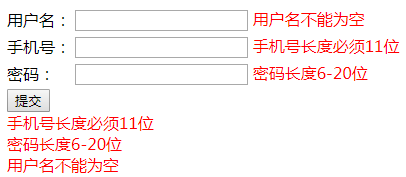表单验证分为前端验证和服务器端验证。
服务器端验证方面,Java提供了主要用于数据验证的JSR 303规范,而Hibernate Validator实现了JSR 303规范。
项目依赖加入spring-boot-starter-thymeleaf时,默认就会加入Hibernate Validator的依赖。
开发环境:IntelliJ IDEA 2019.2.2
Spring Boot版本:2.1.8
新建一个名称为demo的Spring Boot项目。
1、pom.xml
<dependency> <groupId>org.springframework.boot</groupId> <artifactId>spring-boot-starter-web</artifactId> </dependency> <dependency> <groupId>org.springframework.boot</groupId> <artifactId>spring-boot-starter-thymeleaf</artifactId> </dependency> <dependency> <groupId>org.springframework.boot</groupId> <artifactId>spring-boot-devtools</artifactId> </dependency>
2、src/main/java/com/example/demo/User.java
package com.example.demo; import org.hibernate.validator.constraints.Length; import javax.validation.constraints.NotBlank; import javax.validation.constraints.Size; public class User { @NotBlank(message = "用户名不能为空") String name; @Length(min = 11, max = 11, message = "手机号长度必须11位") String phone; @Size(min = 6, max = 20, message = "密码长度6-20位") String password; public String getName() { return name; } public void setName(String name) { this.name = name; } public String getPhone() { return phone; } public void setPhone(String phone) { this.phone = phone; } public String getPassword() { return password; } public void setPassword(String password) { this.password = password; } }
3、src/main/java/com/example/demo/FormController.java
package com.example.demo; import org.springframework.stereotype.Controller; import org.springframework.validation.BindingResult; import org.springframework.validation.ObjectError; import org.springframework.web.bind.annotation.ModelAttribute; import org.springframework.web.bind.annotation.PathVariable; import org.springframework.web.bind.annotation.PostMapping; import org.springframework.web.bind.annotation.RequestMapping; import javax.validation.Valid; import java.util.List; @Controller public class FormController { @RequestMapping("/{form}") public String form(@PathVariable String form, @ModelAttribute User user){ return form; } @PostMapping("/submit") public String submit(@Valid User user, BindingResult result){ if (result.hasErrors()) { List<ObjectError> list = result.getAllErrors(); for (ObjectError error : list) { System.out.println(error.getDefaultMessage()); } return "form"; } //业务逻辑处理 return "form"; } }
4、src/main/resources/templates/form.html
前端通过#fields对象输出错误信息有2种方式,1种是在每个字段后面输出,另1种是全部在一起输出。
<!DOCTYPE html>
<html>
<head>
<meta charset="UTF-8">
<title>表单的提交处理</title>
<style>
.fieldError{color: red}
</style>
</head>
<body>
<form method="post" th:action="@{/submit}" th:object="${user}">
<table>
<tr>
<td>用户名:</td>
<td><input type="text" th:field="*{name}" />
<span class="fieldError" th:if="${#fields.hasErrors('*{name}')}" th:errors="*{name}"></span>
</td>
</tr>
<tr>
<td>手机号:</td>
<td><input type="text" th:field="*{phone}" />
<span class="fieldError" th:if="${#fields.hasErrors('*{phone}')}" th:errors="*{phone}"></span>
</td>
</tr>
<tr>
<td>密码:</td>
<td><input type="text" th:field="*{password}" />
<span class="fieldError" th:if="${#fields.hasErrors('*{password}')}" th:errors="*{password}"></span>
</td>
</tr>
<tr>
<td colspan="2">
<input type="submit" value="提交" />
<div th:each="err : ${#fields.errors('*')}">
<span th:text="${err}" class="fieldError"></span>
</div>
</td>
</tr>
</table>
</form>
</body>
</html>
启动服务后,浏览器访问http://localhost:8080/form,点击提交按钮,结果如下:
